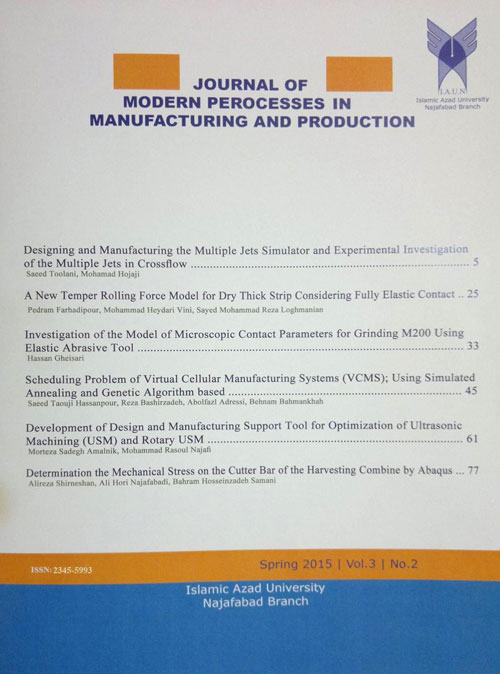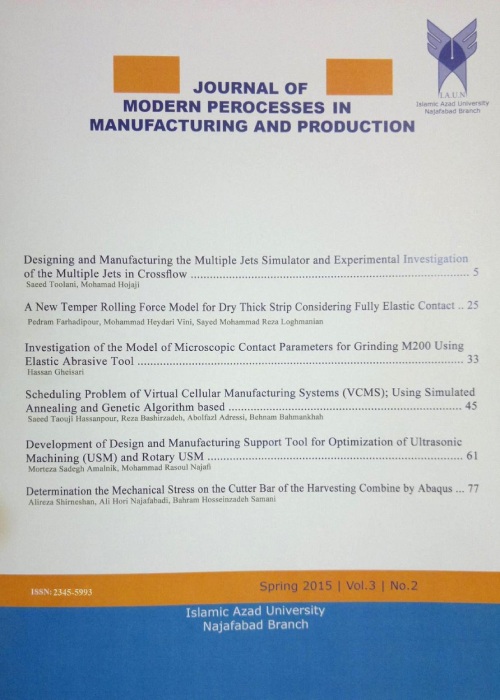فهرست مطالب

Journal of Modern Processes in Manufacturing and Production
Volume:5 Issue: 4, Autumn 2016
- تاریخ انتشار: 1395/10/30
- تعداد عناوین: 7
-
Pages 5-12Metal spinning as a kind of manufacturing process has capability to shape hollow components. In present work shear spinning process is used to formplates into conical shapes. Moreover, the aim of this research is to demonstrate the impact of the process parameters (i.e. feeding rate and spindle speed) on wall thickness. This approachwas done by experimental and finite elements method. The results illustrated that wall thickness decreases while feeding rate increases in spinning process. The experimental results confirm the Finite element analysis (FEA) results during thickness evaluations so this shows that FEA results are reliable for this specific case. The results of analysis reveals that the best condition for spinning is for feeding rate of 40 mm/min and spindle speed of 50 rpm in which highest thickness of 1mm is obtained. In consequence, the findings also illustrated that by decreasing the feeding rate and spindle speed, higher thickeners can be observed during shear spinning process.Keywords: Spinning, Thickness variation, Rotational Speed, FEM, Al-1060
-
Pages 13-19The suppression of the regenerative chatter phenomenon in turning process via the variation of the frequency and amplitude of the spindle motor excitation is carried out in this research. A programmable inverter is employed for variable periodic excitation of the spindle motor. A set of turning experiments is designed and performed on a number of conical work pieces both in constant spindle speeds and variable spindle speeds. The work-piece material was 1.7224 steel. These experiments are carried out in different spindle speeds so that the stability lobes diagram could be achieved. The results showed that the passive variations of the spindle speed increase the critical depth of cut in higher spindle speeds, while in lower spindle speeds it is case sensitive. It also showed that the increasing of the excitation frequency reduces the critical depth of cut, while increasing the amplitude increases the critical chip thickness in lower spindle speeds and reduces that in higher spindle speeds. ated that by decreasing the feeding rate and spindle speed, higher thickeners can be observed during shear spinning process.Keywords: Regenerative Chatter Suppression, Spindle Speed, Excitation Variation, Stability Lobes Diagram
-
Pages 21-33Nowadays the surface texturing has been widely recognized as a usable capability to improve the tribological systems. In this paper, ultrasonic assisted turning (UAT) isperformed to create the micro textures on the flat faces. Micro surface texturing ismade on the Al7075-T6 by the UAT in the face turning process. Then, the influences of cutting speed feed, vibration direction and vibration amplitudeare studied.The effects of process parameterson the friction and wear behaviors of un-textured and textured patterns areinvestigated by the full factorial method. Microscopic images demonstrate the creation of micro dimples on the surfaces.Experimental results showed that textured surfaces can decrease the average friction coefficient and wear rate. The friction coefficient of surfaces generated by the UAT processwasdecreased about 10% in comparison to surfaces generated by conventional face turning.Moreover, because of existence of micro-dimple arrays in surfaces generated by the UAT process, proportion of contact between the pins and textured surfaces reduces. Cutting speed and feed effect on both of the average friction coefficient and wear rate.By increasingofthe cutting speed, feed, vibration amplitude and vibration direction (angle), the average friction coefficient and wear reduce.Keywords: Ultrasonic Assisted Face Turning, Sliding Wear, Surface Topography, Wear Testing
-
Pages 35-44The accumulative roll bonding (ARB) as a severe plastic deformation (SPD) procedure aimed at enhancing the mechanical properties of metals and alloys. In the present study, a new slab method is proposed for estimating the forming stress field for cold extrusion of metals cross the alumina interlayer powder particles by accumulative roll bonding process. Plastic deformation behavior of the metal at the interfaces of the strips was investigated. Distinctive particles arrangements are used for different zones in the extrusion channel in the present models and the forming stress during the extrusion process affected. The corresponding results have also been determined analytically and by using the finite element software, ABAQUS. It was found that the theoretical prediction of the forming stress of the extruded metal cross the interlayer particles is in good compliance with the numerical measurement. Moreover, the interfaces of laminates have been studied to investigate the behavior of particles by scanning electron microscopy (SEM).Keywords: Slab Method, Roll bonding, Interlayer Particles, Aluminum
-
Pages 45-56Surface quality including surface roughness and edge chipping is a key process measure in micro ultrasonic machining (Micro-USM) as an efficient process for micromachining of hard and brittle materials. Process parameters such as ultrasonic vibration amplitude, static load, type of tool material, type and size of abrasive particles and slurry concentration can influence the surface quality. However, there is limited study on the parametric effects on the surface quality in micro-USM. The objective of this study is to investigate the effects of the workpiece material as well as process parameters including abrasive type, particle size and vibration amplitude on surface roughness and edge chipping in micro-USM. Silicon, alumina ceramics and soda-lime glass were selected as workpiece materials and polycrystalline diamond and alumina as abrasives. Particle size ranging from 0.3 to 3 μm and vibration amplitude ranging from 0.8 to 3 μm were selected in this study. Results indicate that workpiece material and vibration amplitude have significant effects on surface roughness. Workpiece material was found to be the most significant parameter with a percentage contribution of about 45 % in the variation of mean Ra, followed by vibration amplitude and particle size of about 28 % and 5% contributions, respectively. Results also show that alumina ceramic is a material capable of achieving better surface quality in micro-USM as compared to silicon and soda-lime glass.Keywords: Micro Ultrasonic Machining, Surface Quality, Edge Chipping, Process Parameters, Experimental Design
-
Pages 57-70Moving car on rough road suddenly gets out of its way for some reason and moves to the edge of the road at the same speed. Since the most important factor in car overturning is vertical acceleration in the wheels and car speed and road conditions determine the vertical instantaneous acceleration, brake system according to change of the spring length is designed in such a way that by monitoring the instantaneous acceleration at the wheels, by interrupting the speeding up and applying the anti-lock braking, this can prevent cars overturning. By placing the sensor on rings of the spring, we can send the changing moment of the spring to the ABS control unit. The sensor which was a kind of Electromagnetic sensors providing these conditions to control the car with precise circuit design at the Simulink section in CARSIM software and three-step interface circuit between the sensor and ABS brakes at Proteus software. In Simulink software the data that is logged as input has car maneuver variables such as longitudinal speed of the car, which after processing the instantaneous information obtained during maneuvering, variables such as pressure in the wheel brake cylinders, are sent to CARSIM software as the output of the system to continue the maneuvering. At Simulink model is designed in three parts that include: designing of simulated car in the software with the existing parameters, control boxes circuit and also switch boxes for system operators which have their task. First, the car goes straight in normal maneuvers, and then it would be tested in the rugged pathways. In this condition, the success and failure of the maneuvering are checking by the equipping and not equipping the car. After these tests, the right real way would be selected and the road will be more completed by placing screws and soil shoulder and margins.Keywords: Length Change, Control Unit, ABS, Simulink, CARSIM, Proteus, Switch Box
-
Pages 71-88Data envelopment analysis (DEA) is a nonparametric approach to estimate relative efficiency of Decision Making Units (DMUs). DEA is one of the best quantitative approaches and balanced scorecard (BSC) is one of the best qualitative methods to measure efficiency of an organization. Since simultaneous evaluation of network performance of the quad areas of BSC model is considered as a necessity and separate use of DEA and BSC is not effective and leads to miscalculation of performance, integrated DEA-BSC model is applied. Regarding to multi-objective nature of the proposed model, two techniques including goal programming and weighted average method are used to solve such problems. At the end of the study, based on data relating to indexes of quad areas of BSC model, the results of the mentioned methods are compared. Besides assessing validation of the proposed model, the overall efficiency and each of the different stages of BSC are obtained. So that, finding a model for decision making units in various stages of BSC is the innovation of this research study.Keywords: Data Envelopment Analysis, Balanced Scorecard, Decision Making Units, Goal Programming, Weighting Objective Function, Multi Objective Programming


